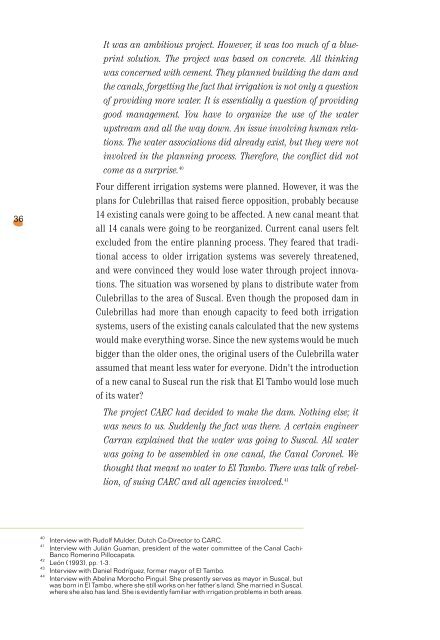mishqui-yacu, sweet water - IFAD
mishqui-yacu, sweet water - IFAD
mishqui-yacu, sweet water - IFAD
You also want an ePaper? Increase the reach of your titles
YUMPU automatically turns print PDFs into web optimized ePapers that Google loves.
36<br />
It was an ambitious project. However, it was too much of a blueprint<br />
solution. The project was based on concrete. All thinking<br />
was concerned with cement. They planned building the dam and<br />
the canals, forgetting the fact that irrigation is not only a question<br />
of providing more <strong>water</strong>. It is essentially a question of providing<br />
good management. You have to organize the use of the <strong>water</strong><br />
upstream and all the way down. An issue involving human relations.<br />
The <strong>water</strong> associations did already exist, but they were not<br />
involved in the planning process. Therefore, the conflict did not<br />
come as a surprise. 40<br />
Four different irrigation systems were planned. However, it was the<br />
plans for Culebrillas that raised fierce opposition, probably because<br />
14 existing canals were going to be affected. A new canal meant that<br />
all 14 canals were going to be reorganized. Current canal users felt<br />
excluded from the entire planning process. They feared that traditional<br />
access to older irrigation systems was severely threatened,<br />
and were convinced they would lose <strong>water</strong> through project innovations.<br />
The situation was worsened by plans to distribute <strong>water</strong> from<br />
Culebrillas to the area of Suscal. Even though the proposed dam in<br />
Culebrillas had more than enough capacity to feed both irrigation<br />
systems, users of the existing canals calculated that the new systems<br />
would make everything worse. Since the new systems would be much<br />
bigger than the older ones, the original users of the Culebrilla <strong>water</strong><br />
assumed that meant less <strong>water</strong> for everyone. Didn't the introduction<br />
of a new canal to Suscal run the risk that El Tambo would lose much<br />
of its <strong>water</strong>?<br />
The project CARC had decided to make the dam. Nothing else; it<br />
was news to us. Suddenly the fact was there. A certain engineer<br />
Carran explained that the <strong>water</strong> was going to Suscal. All <strong>water</strong><br />
was going to be assembled in one canal, the Canal Coronel. We<br />
thought that meant no <strong>water</strong> to El Tambo. There was talk of rebellion,<br />
of suing CARC and all agencies involved. 41<br />
40<br />
41<br />
42<br />
43<br />
44<br />
Interview with Rudolf Mulder, Dutch Co-Director to CARC.<br />
Interview with Julián Guaman, president of the <strong>water</strong> committee of the Canal Cachi-<br />
Banco Romerino Pillocapata.<br />
León (1993), pp. 1-3.<br />
Interview with Daniel Rodríguez, former mayor of El Tambo.<br />
Interview with Abelina Morocho Pinguil. She presently serves as mayor in Suscal, but<br />
was born in El Tambo, where she still works on her father’s land. She married in Suscal,<br />
where she also has land. She is evidently familiar with irrigation problems in both areas.
















